

Stereoscopy. Pocket stereoscope with original test image.
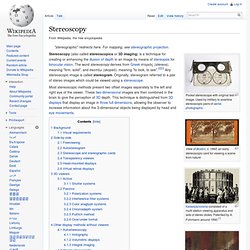
Used by military to examine stereoscopic pairs of aerial photographs. View of Boston, c. 1860; an early stereoscopic card for viewing a scene from nature Kaiserpanorama consisted of a multi-station viewing apparatus and sets of stereo slides. Patented by A. Fuhrmann around 1890.[1] Company of ladies watching stereoscopic photographs, painting by Jacob Spoel, before 1868. Stereoscopy (also called stereoscopics or 3D imaging) is a technique for creating or enhancing the illusion of depth in an image by means of stereopsis for binocular vision. Background[edit] Stereoscopy creates the illusion of three-dimensional depth from given two-dimensional images.
Lord Byron. He travelled all over Europe especially in Italy where he lived for seven years and then joined the Greek War of Independence fighting the Ottoman Empire, for which Greeks revere him as a national hero.[1] He died one year later at age 36 from a fever contracted while in Missolonghi in Greece.

Often described as the most flamboyant and notorious of the major Romantics, Byron was celebrated in life for aristocratic excesses, including huge debts, numerous love affairs with both sexes, rumours of a scandalous incestuous liaison with his half-sister, and self-imposed exile.[2] Early life[edit] Byron's paternal grandparents were Vice-Admiral the Hon. General relativity. General relativity, or the general theory of relativity, is the geometric theory of gravitation published by Albert Einstein in 1916[1] and the current description of gravitation in modern physics.
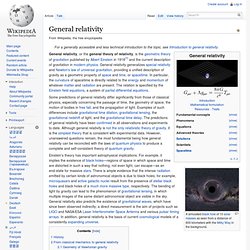
General relativity generalizes special relativity and Newton's law of universal gravitation, providing a unified description of gravity as a geometric property of space and time, or spacetime. In particular, the curvature of spacetime is directly related to the energy and momentum of whatever matter and radiation are present. The relation is specified by the Einstein field equations, a system of partial differential equations. Chaos theory. A double rod pendulum animation showing chaotic behavior.
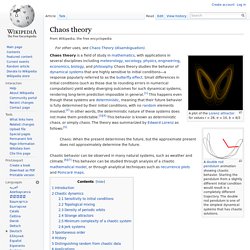
Starting the pendulum from a slightly different initial condition would result in a completely different trajectory. The double rod pendulum is one of the simplest dynamical systems that has chaotic solutions. Schrödinger's cat. Schrödinger's cat: a cat, a flask of poison, and a radioactive source are placed in a sealed box.
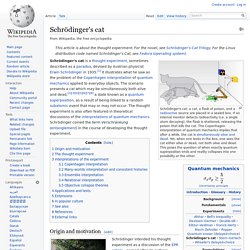
If an internal monitor detects radioactivity (i.e. a single atom decaying), the flask is shattered, releasing the poison that kills the cat. The Copenhagen interpretation of quantum mechanics implies that after a while, the cat is simultaneously alive and dead. Yet, when one looks in the box, one sees the cat either alive or dead, not both alive and dead.
This poses the question of when exactly quantum superposition ends and reality collapses into one possibility or the other. Schrödinger's cat is a thought experiment, sometimes described as a paradox, devised by Austrian physicist Erwin Schrödinger in 1935.[1] It illustrates what he saw as the problem of the Copenhagen interpretation of quantum mechanics applied to everyday objects. Origin and motivation[edit] Bohr–Einstein debates. The Bohr–Einstein debates were a series of public disputes about quantum mechanics between Albert Einstein and Niels Bohr, who were two of its founders.
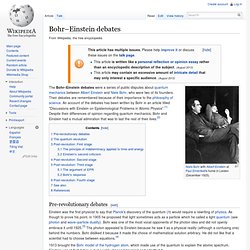
Their debates are remembered because of their importance to the philosophy of science. An account of the debates has been written by Bohr in an article titled "Discussions with Einstein on Epistemological Problems in Atomic Physics".[1] Despite their differences of opinion regarding quantum mechanics, Bohr and Einstein had a mutual admiration that was to last the rest of their lives.[2] Pre-revolutionary debates[edit] Einstein was the first physicist to say that Planck's discovery of the quantum (h) would require a rewriting of physics. As though to prove his point, in 1905 he proposed that light sometimes acts as a particle which he called a light quantum (see photon and wave–particle duality).
Rapid eye movement sleep. Rapid eye movement (REM) sleep is a stage of sleep characterized by the rapid and random movement of the eyes.

Rapid eye movement sleep is classified into two categories: tonic and phasic.[1] It was identified and defined by Nathaniel Kleitman and his student Eugene Aserinsky in 1953. Criteria for REM sleep includes rapid eye movement, low muscle tone and a rapid, low-voltage EEG; these features are easily discernible in a polysomnogram,[2] the sleep study typically done for patients with suspected sleep disorders.[3] REM sleep typically occupies 20–25% of total sleep, about 90–120 minutes of a night's sleep. Richard Wagner. The Holocaust. The Holocaust (from the Greek ὁλόκαυστος holókaustos: hólos, "whole" and kaustós, "burnt")[2] also known as Shoah (Hebrew: השואה, HaShoah, "the catastrophe"; Yiddish: חורבן, Churben or Hurban, from the Hebrew for "destruction"), was the mass murder or genocide of approximately six million Jews during World War II, a programme of systematic state-sponsored murder by Nazi Germany, led by Adolf Hitler and the Nazi Party, throughout the German Reich and German-occupied territories.[3] Of the nine million Jews who had resided in Europe before the Holocaust, approximately two-thirds were killed.[4] Over one million Jewish children were killed in the Holocaust, as were approximately two million Jewish women and three million Jewish men.[5] A network of over 40,000 facilities in Germany and German-occupied territory were used to concentrate, hold, and kill Jews and other victims.[6] The persecution and genocide were carried out in stages.

Etymology and use of the term Distinctive features Origins. Tsar Bomba. Coordinates: 73°48′26″N 54°58′54″E / 73.80722°N 54.98167°E / 73.80722; 54.98167 Tsar Bomba (Russian: Царь-бомба; "Tsar Bomb", "Emperor Bomb", Tsar being derived from Caesar) is the nickname for the AN602 hydrogen bomb, the most powerful nuclear weapon ever detonated.
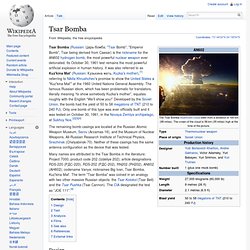
Its October 30, 1961 test remains the most powerful artificial explosion in human history. It was also referred to as Kuz'kina Mat' (Russian: Кузькина мать, Kuzka's mother),[1] referring to Nikita Khrushchev's promise to show the United States a "Kuz'kina Mat'" at the 1960 United Nations General Assembly. The famous Russian idiom, which has been problematic for translators, literally meaning “to show somebody Kuzka's mother”, equates roughly with the English “We’ll show you!” History of technology. The wheel was invented in the 4th millennium BC, and has become one of the world's most famous, and most useful technologies.
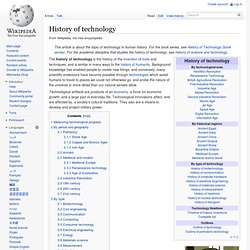
This wheel is on display in The National Museum of Iran, in Tehran. The history of technology is the history of the invention of tools and techniques, and is similar in many ways to the history of humanity. Background knowledge has enabled people to create new things, and conversely, many scientific endeavors have become possible through technologies which assist humans to travel to places we could not otherwise go, and probe the nature of the universe in more detail than our natural senses allow. Indo-European languages. Time Person of the Year. History[edit] Leviathan (book) English Civil War. The English Civil War (1642–1651) was a series of armed conflicts and political machinations between Parliamentarians ("Roundheads") and Royalists ("Cavaliers") in the Kingdom of England over, principally, the manner of its government.
The first (1642–46) and second (1648–49) wars pitted the supporters of King Charles I against the supporters of the Long Parliament, while the third (1649–51) saw fighting between supporters of King Charles II and supporters of the Rump Parliament. The war ended with the Parliamentarian victory at the Battle of Worcester on 3 September 1651. The overall outcome of the war was threefold: the trial and execution of Charles I; the exile of his son, Charles II; and the replacement of English monarchy with, at first, the Commonwealth of England (1649–53) and then the Protectorate (1653–59) under Oliver Cromwell's personal rule.
Terminology[edit] Background[edit] The King's rule[edit] Charles I, painted by Van Dyck Personal rule[edit] Rebellion in Scotland[edit] Ralph Waldo Emerson. Ralph Waldo Emerson (May 25, 1803 – April 27, 1882) was an American essayist, lecturer, and poet, who led the Transcendentalist movement of the mid-19th century. He was seen as a champion of individualism and a prescient critic of the countervailing pressures of society, and he disseminated his thoughts through dozens of published essays and more than 1,500 public lectures across the United States. He remains among the linchpins of the American romantic movement,[3] and his work has greatly influenced the thinkers, writers and poets that have followed him. When asked to sum up his work, he said his central doctrine was "the infinitude of the private man. "[4] Emerson is also well known as a mentor and friend of fellow Transcendentalist Henry David Thoreau.[5]
Guy Fawkes. Guy Fawkes (13 April 1570 – 31 January 1606), also known as Guido Fawkes, the name he adopted while fighting for the Spanish in the Low Countries, was a member of a group of provincial English Catholics who planned the failed Gunpowder Plot of 1605. Fawkes was born and educated in York. His father died when Fawkes was eight years old, after which his mother married a recusant Catholic. Fawkes later converted to Catholicism and left for the continent, where he fought in the Eighty Years' War on the side of Catholic Spain against Protestant Dutch reformers.
He travelled to Spain to seek support for a Catholic rebellion in England but was unsuccessful. He later met Thomas Wintour, with whom he returned to England. Wintour introduced Fawkes to Robert Catesby, who planned to assassinate King James I and restore a Catholic monarch to the throne. Low Countries. The Low Countries as seen from space. Czechoslovakia. Czechoslovakia (or Czecho-Slovakia;[1] Czech and Slovak: Československo, Česko-Slovensko)[2] was a sovereign state in Central Europe that existed from October 1918, when it declared its independence from the Austro-Hungarian Empire, until its peaceful dissolution into Czechia and Slovakia on 1 January 1993.
From 1939 to 1945, following its forced division and partial incorporation into Nazi Germany, the state did not de facto exist but its government-in-exile continued to operate. Austria-Hungary. Austrian Empire. Mach number. Northrop Grumman B-2 Spirit. The Northrop Grumman B-2 Spirit, also known as the Stealth Bomber, is an American strategic bomber, featuring low observable stealth technology designed for penetrating dense anti-aircraft defenses; it is able to deploy both conventional and nuclear weapons. The bomber has a crew of two and can drop up to eighty 500 lb (230 kg)-class JDAM GPS-guided bombs, or sixteen 2,400 lb (1,100 kg) B83 nuclear bombs. The B-2 is the only aircraft that can carry large air-to-surface standoff weapons in a stealth configuration.